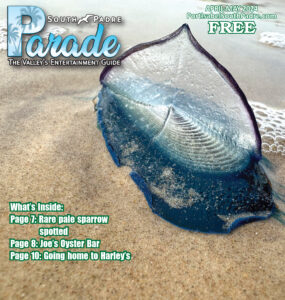By Steve Hathcock
Ellen Kyle sent an email recently asking if I “knew what happened to the little green house that once stood on the corner of Haas and Padre Blvd.?”
“Yes I do,” was my reply, “in fact, I was there when it happened.”
(Early morning May 30, 2010) “My dad paid $50 for this place in 1949,” Walt said as we watched the operator manipulate levers at the control panel of the combination end-loader backhoe.
Suddenly, the machine leaped forward, smashing its heavy steel bucket atop the roof near the northeastern wall. The sound of splintering wood and breaking glass was drowned out by the roar of a passing motorcycle.
The building shook and swayed, then settled back onto its foundation of weathered pilings. Again and again, the shovel hammered down upon the house. Tufts of insulation were caught up in the wind. The demolition paused as a flowing water hose was used to wet down any dust that might have become airborne.
Taking advantage of the lull, we moved closer to the building while Walt continued his narrative.
“Mom was angry with him for spending that much money for a fishing camp on a deserted island. A year passed before she ever saw the place and that was just because someone had offered dad $500 for it. She figured she should see it at least one time.”
“Of course after spending one weekend on Padre Island, she told my dad that under no circumstances was this fishing camp for sale,” Walt said. “From that day on we spent as much time fishing, swimming or beachcombing on the Island as we could. We were one of five families with fishing camps on Padre Island at that time. Four of them were surplus Coast Guard huts that had housed the units called “Sand-Pounders” that patrolled Padre Island during the war. Ours had originally served as a platform for an observation tent that stood along Brazos Pass. The old fisherman who sold my dad the house had added the walls with large holes cut in them to provide ventilation”
“Look there”, he said pointing to a section of the wall, “these are the original ‘Arkansas Shutters.’ You can see how they hung from straps. We had a set of pulleys inside the cabin and
could pull on the rope to open them to whatever degree we desired. We nailed them shut and covered them with the siding sometime in the 1950s.”
“That was after we moved it here the second time,” he said.
What do you mean, the second time? I asked.
“Well, originally the county told us we had to move the cabin from the jetties because they were going to develop Isla Blanca Park. I remember my dad paying Mr. Thompkins $100 for the land. Some men came over and walked around a bit. Then they stuck some steel rods with red ribbons into the ground. ‘Them’s your property lines’ they told us. Believing them, dad had the house set down about 100 feet to the west.”
That would put it right about in the middle of Padre Blvd, I thought to myself, as I looked where Walt’s finger pointed.
“Six months later some more men came around with maps and fancy equipment. Unlike the first group to drive the rods these were real surveyors. Boy was dad mad when the county told him he had to move the house to get out of the way of a non-existent road!”
During the 1950-70s, the Galloway family continued to spend as much time as they could in their little beach house. A new addition was added onto the rear and real windows replaced the swing up shutters. A pitched roof, weather proofed with tar paper and shingles, ensured a dry interior.
Asbestos siding and linoleum were also installed. More modern luxuries followed including electricity, running water and a window air conditioning unit. About 30 years ago, the family made the beach house available to the Rio Grande Children’s Home in Mission whose residents spent many a weekend on the beaches of South Padre Island.
Though it had withstood the ravages of hurricanes and war, the Galloway House could not resist the effects of the noiseless tooth of time and the day came when the decision had to be made and the old building was demolished. An Island landmark disappeared, gone in a blink with nothing except a scar on the earth to mark its passing.




Comments